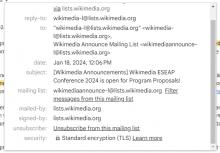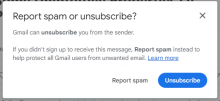Background:
- Email sender guidelines: https://support.google.com/a/answer/81126
- "Important: Starting February 2024, Gmail will require the following for senders who send 5,000 or more messages a day to Gmail accounts: Authenticate outgoing email, avoid sending unwanted or unsolicited email, and make it easy for recipients to unsubscribe."
- Wikimedia:
A large Phorge instance can easily generate more than 5000 messages a day from Maniphest tasks. Wikimedia's likely sends somewhere in the 10-15k range, at least. While not all of those go to Google-controlled domains, a good many of them must.
From the sender guidelines:
Make it easy to unsubscribe
Always give your recipients an easy way to unsubscribe from your messages. Letting people opt out of your messages can improve open rates, click-through rates, and sending efficiency. One-click unsubscribe makes it easy for people to opt out. If you send more than 5,000 message per day, your marketing and subscribed messages must support one-click unsubscribe.
To set up one-click unsubscribe, include both of these headers in outgoing messages:
- List-Unsubscribe-Post: List-Unsubscribe=One-Click
- List-Unsubscribe: <https://solarmora.com/unsubscribe/example>
When a recipient unsubscribes using one-click, you receive this POST request:
"POST /unsubscribe/example HTTP/1.1 Host: solarmora.com Content-Type: application/x-www-form-urlencoded Content-Length: 26 List-Unsubscribe=One-Click"Learn more about List-Unsubscribe: headers in RFC 2369 and RFC 8058.
Mail from Maniphest currently includes a prominent link to email preferences, but does not set List-Unsubscribe or List-Unsubscribe-Post headers as far as I can tell.
I am guessing, but have not yet investigated, that setting a simple List-Unsubscribe would be relatively trivial, while the one-click version could be quite a bit more involved.
I also don't have a clear picture of what else besides tasks might send a lot of mail, or if it would be necessary to make changes in more than one place.



